We’re approaching 2026, and we’re seeing that subscription models have finally gone physical. What began as a space dominated by SaaS, consumables, and digital content has opened its doors to a new category — consumer durable products delivered as a service.
But the space isn’t really new, as the models have been evolving quietly for years. Startups in mobility, baby goods, and home tech have been building product-as-a-service businesses long before it went mainstream, with the likes of Lenovo TruScale, Mister Spex Switch, Decathlon Rentals and more joining.
In other words, the big players have arrived.
And they’re discovering what early moves already know — you cannot incorporate a subscription-based model into your existing sales-based processes.
If you want to understand what truly sets subscription business models apart from traditional sales, and how digital, consumable, and physical product subscriptions each operate differently, check out this guide: How subscription-management software for physical products: What makes it different (And what to look for).
This article cover:
- What companies learned when they tried subscriptions
- What is subscription management
- Key operations you need to plan for when operating physical, consumer durable product subscriptions
- Why a subscription business needs a subscription management solution
- Software & solution recommendation guide
- Operations to plan for when running a subscription business for physical products
What companies learned when they tried subscriptions
Bugaboo, a Dutch manufacturer of baby goods with about 935 employees and €233 million in revenue, experienced this firsthand when they launched their rental pilot for its iconic strollers in 2016.
“Our first rental pilot was unsuccessful because we tried to incorporate the rental business into our existing ERP tool and into our existing process of sales, finance, and logistics—which was a huge mess and didn’t work out.” — Rolf Smeding, Director of New Business Development at Bugaboo
And Miele, a global leader in premium appliances with ~23,500 employees and annual revenue of ~€5.04 billion, put it perfectly when describing the internal shift toward subscription models:
“Every single process you are used to doing when selling on a transaction basis is still there and is driving 99.95% of your revenue and your daily business. So it’s quite challenging to change the processes to fit with subscription models and is a big undertaking.”
Stokke, the Norwegian company behind the iconic Tripp Trapp chair, highlighted the same challenge when exploring subscription-based models as part of their business model innovation:
“”Renting is a completely different process than selling. We realised that we needed dedicated processes and our existing selling processes were not made for handling rentals.
Together, these insights from leading consumer brands reveal a hard truth: building a product-as-a-service model isn’t just about adding a subscription button — it’s about re-engineering how your business runs.
What is subscription management
Like any software solution, a subscription management platform helps businesses automate and scale the operations tied to their subscription model. But here’s the thing — what those operations actually look like depends entirely on what kind of subscription you’re running.
A subscription for digital services (like Netflix) and one for consumables (like coffee or vitamins) might share similar workflows — renewals, payments, invoicing — but a physical product subscription adds layers of operational complexity that traditional tools aren’t built for.
Take renewals, for example.
In digital subscriptions, renewals are simple — your card is charged, and your access continues. In consumable subscriptions, it’s the same — your next box just ships. But for physical products, renewals can mean something entirely different:
- The price might change after the minimum subscription duration.
- The product might need to be swapped, upgraded, or bought out.
- The renewal could trigger new logistics steps, like checking product condition or scheduling a replacement.
And that’s just one operational difference. Once you look deeper — into returns, refurbishments, repairs, inventory, and asset tracking — it becomes clear that physical product subscriptions need a different kind of software. That’s exactly what this list is about: the tools built (or evolving) to support the unique operational needs of physical and consumer durable product subscriptions.
Key operations you need to plan for when operating physical, consumer durable product subscriptions
Running a subscription business for physical products involves more than just setting up recurring billing. It’s an entirely different operational model that requires rethinking how you handle orders, payments, renewals, and more. Below is a breakdown of the most important operations to plan for.
1. Order Placement & Mixed Baskets
Customers or let's say subscribers of physical products, often mix one-time, digital, and subscription items in one cart such as coffee machine with insurance and regular delivery of coffee beans or a bike subscription with insurance and theft protection or a music instrument with music lessons. Your system should be able to combine them into a single order, invoice, and shipment — most eCommerce platforms can’t handle that cleanly.
2. Recurring Billing
Physical subscriptions need editable billing — adjusting prices, dates, or durations mid-contract without rebuilding the subscription. Flexibility is non-negotiable for long-term relationships.
3. Renewals & Subscription Extensions
Renewals aren’t just another payment — they can trigger pricing changes, upgrades, or loyalty extensions. Systems must support this operational logic automatically.
4. Payment Retries
Cards expire and payments fail. Automated retries and notifications prevent revenue leakage without manual tracking.
5. Debt Collection
When retries fail, you need workflows (or partners) to handle unpaid invoices — especially when valuable assets are still with customers.
6. Identity & Credit Checks
Unlike digital subscriptions, physical goods carry risk. Integrating soft credit or ID checks ensures reliability before products ship.
7. Asset Tracking
You own the product, so you must know where it is, its condition, and its revenue history. Asset tracking links products, customers, and revenue into one lifecycle view.
8. Return Management
Returns close the subscription loop — systems must trigger communications, monitor returns, and continue or stop billing automatically based on status.
9. Backend Order Creation & POS
Subscriptions shouldn’t be limited to online checkout. Your system should enable in-store or partner-driven order creation that syncs seamlessly with your backend.
10. Customer Self-Service Portal
Customers expect transparency — the ability to manage payments, upgrades, and returns without contacting support is now table stakes.
11. Buyouts & Product Purchases
If customers want to keep the product, your system must calculate buyout prices, close subscriptions, and update stock automatically.
12. Swaps, Upgrades & Downgrades
Flexibility drives retention — customers should be able to switch products mid-subscription while your system updates billing and inventory behind the scenes.
13. Referral Programs & Loyalty Discounts
Incentives like bonus months or reduced fees boost retention — but they only scale if managed automatically in billing and CRM logic.
14. Key Metrics & KPIs
Track what truly matters: asset revenue, repair costs, and MRR alongside customer lifetime value. Data should link product, customer, and payment cycles.
15. Refunds
Refunds for late deliveries or product issues must tie back to specific billing cycles — otherwise reconciliation becomes chaos.
16. Cancellations
Clear rules and automated flows reduce confusion. The system should manage timing, communication, and payment stops automatically.
17. One-Time Charges
Damage fees or out-of-warranty repairs need to be logged and charged against existing subscriptions for complete revenue tracking.
18. Full Lifecycle Overviews
A strong system connects customer, product, subscription, and payment histories — giving you full operational visibility in one place.
19. Bundling & Multi-Item Tracking
Even bundled orders (like a bike + helmet + lock) must track each asset separately for returns, replacements, and billing accuracy.
20. Product Exchange Logic
If customers can swap products, your platform should apply clear eligibility and price rules while maintaining lifecycle accuracy.
21. Localisation: Tax & Shipping
Physical products cross borders — your software should adapt taxes, VAT, and shipping automatically based on region and order type.
22. Automated Transactional Emails
Every operational event — renewals, payments, returns, cancellations — should trigger automated, clear communication to build trust and reduce support tickets.
Why a subscription business needs a subscription management solution
In our experience, many companies that traditionally sell products and are now exploring subscriptions start with one simple goal: prove demand fast.
And while we at circuly always recommend setting up a subscription management solution from day one, we’ve also seen that in the very early stages — say, up to around 50 active subscriptions — the model can technically be managed with spreadsheets, a payment link, and a few determined team members.
It works as long as operations stay simple: no integrations, no special billing rules, no self-service for customers. In other words, when you’re just testing if people will subscribe at all.
That usually means one or two people handling everything manually — charging payments, sending invoices, answering emails, and updating records. It’s doable, but it’s not scalable. Once you see traction, this setup becomes a bottleneck overnight.
Here’s what changes once you adopt a subscription management solution:
1. Automation and scalability of operations
Standard subscription operations — payments, invoicing, renewals, returns, swaps — need to run on autopilot. Automation isn’t just about saving manual effort; it’s what keeps the customer experience seamless. Customers shouldn’t have to wait days for a manual update, an invoice, or a referral code.
Automation ensures the complexity of the business model doesn’t spill over into the customer journey — everything feels simple on the outside, even when it’s complex underneath.
2. Reduced support tasks and costs
Without automation, customer support becomes your bottleneck — and your biggest cost. A simple product change request can turn into a multi-day process involving multiple people.
With a subscription management solution like circuly, these core operations — renewals, buyouts, cancellations, and returns — can be fully automated or triggered through self-service. That frees your team to focus on strategic support, upselling, or relationship building instead of repetitive admin work.
3. Centralised, Aactionable Data
One of the biggest benefits of running a subscription model is data — but only if it’s captured properly.
A subscription management system combines product, customer, payment, and subscription data in one place.
That means you can track:
- Customer metrics (LTV, churn, referrals, retention)
- Product metrics (revenue per asset, repair frequency, usage cycles)
- Financial metrics (MRR, failed payments, refunds, buyouts)
These insights power better decisions across all fronts — from product design (what breaks, what gets returned) to marketing (who stays longest and why) and finance (how recurring revenue evolves).
4. Improved customer lifetime value and Lloyalty
A subscription management solution doesn’t just automate workflows — it helps you build relationships that last. By making it easy to renew, upgrade, or buy out products, you keep customers engaged longer.
More engagement leads to higher Customer Lifetime Value (CLTV), stronger word of mouth, and increased loyalty — all while providing valuable insights into how your product performs in real-world conditions.
5. Foundation for long-term Ggrowth
Manual processes can prove a concept, but software systems scale it.
A dedicated subscription management solution gives your business the infrastructure to grow — whether that means launching in new markets, integrating with your ERP or PSP, or supporting multiple subscription models simultaneously.
Best subscription management solution for physical, consumer durable products
A few words on how we picked these tools: When we recommend software, we’re not guessing. We look at two things:
1. Who uses it.
We go through the customer examples on each tool’s website and check whether those customers actually deal in consumer durables or physical products.
2. How it performs for real-world operators.
If a tool passes the first test, we analyse it across key parameters based on our own experience helping hundreds of companies launch, manage, and scale subscription models for physical products.
Those parameters reflect what we’ve heard repeatedly from successful operators — the features and workflows that really matter once you’re past the pilot stage and managing thousands of active subscriptions.
#1 circuly - Subscription management solution dedicated to physical product subscriptions
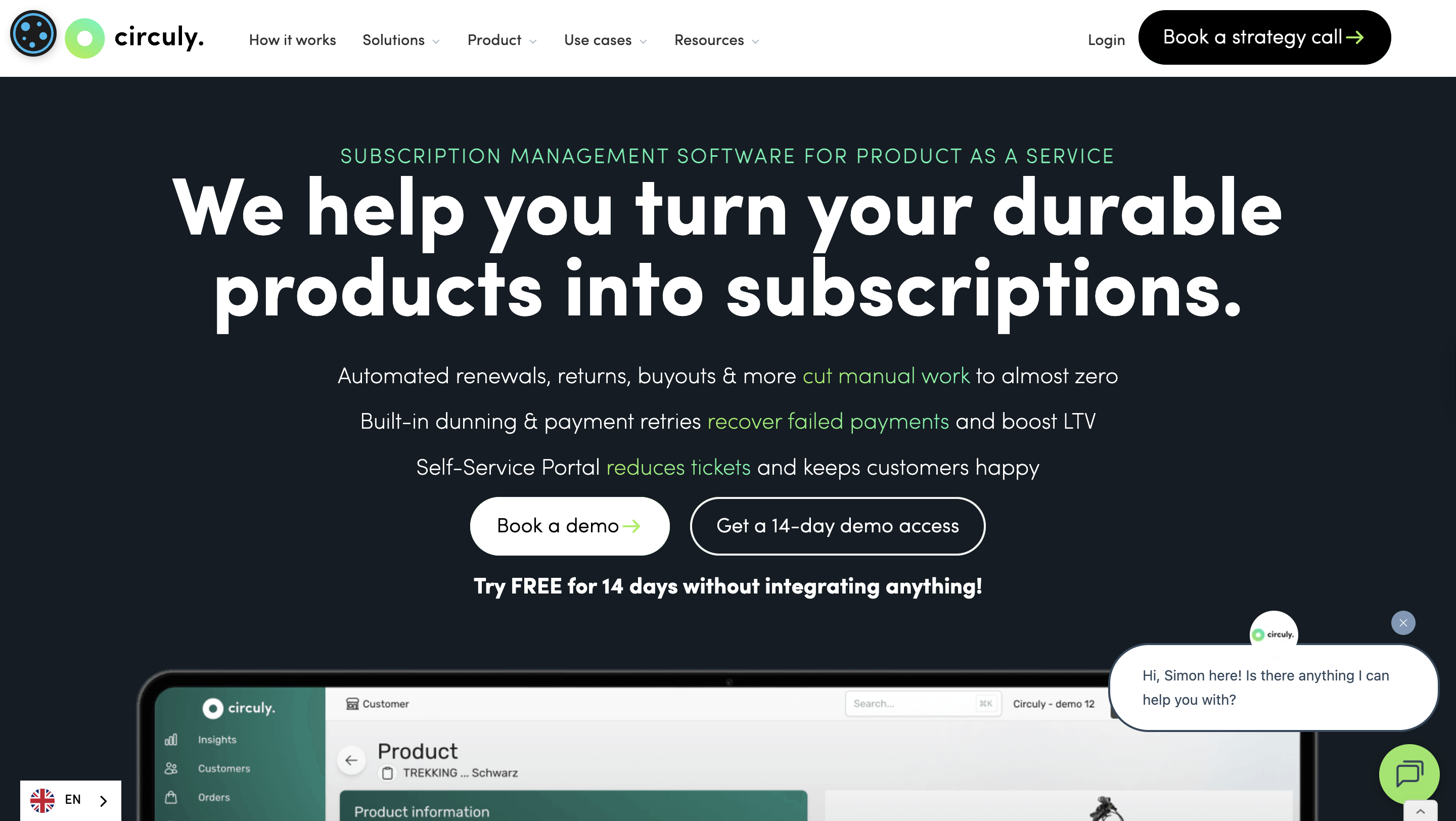
G2 rating: 5/5
OMR rating: 5/5
What it is
circuly is a subscription management platform built for physical and consumer durable products. The platforms is designed to enable brands to launch a subscription-based offering and manage & scale operations. It integrates with shops, payment systems, offers APIs & webhooks, and supports asset tracking, returns, and operational automations.
Typical customers & industries that use circuly
circuly is used by brands across 18+ industries including baby & kids goods, mobility (bikes, scooters), consumer electronics, appliances, medical equipment, furniture, and more. Some named customers / references include Mister Spex, Decathlon, Joule, Bugaboo, Riese & Müller, StrollMe, Homebound, TIER (mobility) and more.
Core functionality
1. Subscription management
Subscription management for a physical product subscription business means combining the following:
- Customer data (name, address, contact)
- Product data (asset, SKU, serial number)
- Payment data (payment method)
- Subscription data (billing frequency, schedule, amount)
To create a subscription plan that links a person to a specific physical product under a recurring contract so that the subsequent operations of renewals, swaps, upgrades, downgrades, etc., can run concurrently and while keeping every system (shop, PSP, ERP, logistics & more) in sync. circuly does exactly that in order to automate key subscription operations like renewals, swaps, upgrades, downgrades and more.
2. Recurring billing & invoicing
Recurring billing, at its core, is about automating the charging process — but in a physical product subscription, it’s also about keeping billing flexible enough to match real-world changes.
Here's how circuly deals with recurring billing: The process starts the moment a customer signs up. A billing schedule is automatically created for that subscription. On each billing date, the system:
- Generates an invoice
- Sends it to the customer
- Triggers the payment collection through the connected payment provider
- Updates the subscription with the correct payment status (e.g., paid, failed, pending)
That’s the baseline. But for businesses dealing in physical products, the reality is rarely that linear.
Subscription plans often need to evolve over time — customers pause, upgrade, downgrade, or swap products mid-cycle. That’s why circuly adds an extra layer of flexibility to its billing logic.
Operators can:
- Edit subscription attributes such as billing amount, frequency, or next charge date without breaking the contract
- Modify or regenerate invoices when adjustments are needed (for example, refunds, prorations, or condition-based billing)
- Create cumulative invoices for multiple items or billing periods
- Factor in dynamic adjustments like referral bonuses, discounts, or loyalty credits, and have those automatically reflected in subsequent invoices
This flexibility is what makes circuly’s recurring billing and invoicing module so powerful for product-as-a-service models — it treats billing not as a static process, but as a living workflow that adapts to real customer and product behaviour.
3. Built in payment retrial & dunning
circuly provides payment dunning and payment retrial natively within its solution. Failed payments are part of every subscription business, but with physical products, they carry a higher risk because there’s an asset still out in the field.
circuly automates the entire payment retrial and dunning process so you don’t have to chase customers manually. When a payment fails, circuly automatically retries it based on customisable rules (number of attempts and delay between retries). If payments continue to fail, the system triggers automated dunning actions — sending reminders and payment links to the customer.
For unresolved cases, circuly integrates natively with Debtist, enabling seamless pre-judicial and judicial debt collection without leaving the platform.
The result: fewer manual interventions, faster cash recovery, and protection against asset losses — all handled directly inside circuly
4. Credit check & fraud prevention
circuly also porvides credit check & fraud prevention solution natively within its solution. In a physical product subscription, every transaction carries real risk — you’re not just billing for access, you’re shipping an asset. That’s why circuly includes an integrated credit check and fraud prevention layer right at checkout. Before a subscription is activated, circuly verifies the customer’s identity and assesses their creditworthiness through connected credit check partners.
This helps businesses automatically flag high-risk customers, reduce fraud-related losses, and make smarter approval decisions — all without disrupting the customer experience. The process is fully automated and happens behind the scenes, giving operators confidence that every shipped product goes to a verified customer.
5. Locatisation, shipping & taxes
Running a physical product subscription across markets means handling local differences — currencies, languages, tax rules, and shipping logic.
circuly supports localisation out of the box, allowing businesses to operate subscriptions in multiple countries with region-specific tax rates (like VAT), translations, and currencies. It also connects with your existing shop system and shipping workflows, ensuring that shipping details, delivery statuses, and country-based configurations stay in sync. In short, circuly helps you stay compliant and consistent — no matter where your customers are or how your logistics are structured.
6. Subscription KPIs & Analytics
circuly has a solution for subscription KPIs & analytics by providing a central dashboard with all the key metrics you need to track your subscription business — not just revenue numbers, but the health of your operations and assets.
You’ll find standard subscription KPIs like:
- Monthly Recurring Revenue (MRR)
- Customer Lifetime Value (CLTV)
- Active subscriptions
- Failed payments and invoice revenue
But since physical products come with real assets, circuly also surfaces product-level insights such as:
- Number of rental cycles per asset
- Total revenue generated per product
- Number and cost of repairs
- Asset utilisation and lifecycle status
All data is exportable via CSV or webhooks, so you can plug circuly’s analytics directly into other tools or automate reporting. In short, circuly gives you full visibility — from subscription performance to asset profitability — in one place.
7. CRM capabilities
While circuly is not a full CRM replacement, it includes a focused CRM layer tailored to subscription and rental operations.
What circuly’s CRM covers:
- Centralised customer profile: All customer information — orders, subscriptions, payments, invoices, and history — lives in one place.
- Customisable customer fields: You can change personal details (name, address, billing address) and add custom customer attributes.
- Transaction & subscription actions from profile: From the same dashboard you can perform refunds, swaps, subscription updates, or cancellations.
- Self-service customer portal: Customers can manage their subscriptions themselves (update billing, change address, view history) via the white-label portal.
- Transactional emails only: The inbuilt CRM handles operational, transactional communications (invoices, payment reminders, subscription notifications), but not marketing emails or rich campaign tools.
- Customisable processes: You can tailor workflows for renewals, extensions, cancellations, and term changes to match business logic.
What circuly’s CRM is not (and how it interacts with external CRMs)
- circuly does not replace a full CRM like Salesforce or HubSpot; it’s designed to complement it.
- For full sales pipeline, lead scoring, marketing automation, and deep customer engagement, you'd keep your external CRM and sync it with circuly.
8. Return Management
In a physical product subscription, the end of a contract isn’t the end of the process — it’s the start of reverse logistics.
circuly automates the return flow by tracking each subscription’s end date. When a subscription is set to expire and no renewal is planned, circuly automatically:
- Generates and sends a return label to the customer.
- Monitors the return status of the product through integrated tracking.
- Updates the asset status once the return is completed, so it can be inspected, refurbished, and reintroduced into inventory.
If the product isn’t returned within the defined time frame, circuly can automatically restart the subscription and continue charging recurring payments until the asset is back.
What makes return management for physical products unique is the operational dependency — it connects billing, logistics, and asset tracking. circuly closes that loop by ensuring finance knows when to stop billing, operations knows when to expect a product, and inventory knows when it’s back in stock.
9. Asset & product tracking
With physical product subscriptions, knowing who has what — and in what condition — is everything. circuly connects each subscription directly to a specific asset, allowing you to track its full lifecycle: where it is, who’s using it, how long it’s been in use, and when it’s due back. Each product or SKU can have its own serial number, condition status, and utilization history.
Beyond tracking, circuly also maintains an overview of every asset’s state — whether it’s currently rented, bought out, under repair, or marked as lost. Stock levels are automatically updated to reflect these changes, ensuring that your inventory data always mirrors reality.
In short, asset tracking in circuly isn’t just about knowing where products are — it’s about keeping your entire stock, operations, and finance teams aligned on what’s available, what’s in use, and what’s generating revenue.
10. Customer transnational communication
In a subscription business, especially one involving physical products, communication isn’t just nice to have — it’s operational. circuly automates transactional customer communication throughout the subscription lifecycle. Customers receive timely emails for key events such as:
- Subscription confirmations and contract details
- Invoice and payment notifications
- Failed payment reminders
- Return instructions or renewal updates
These messages are automatically triggered by system events and keep customers informed without manual follow-up. All communication templates can be customised to match your brand tone and language, ensuring a consistent experience while reducing the need for operational handholding
11. Compliance
Compliance in subscription businesses goes beyond payments — it’s about operating within consumer, financial, and data protection laws across multiple markets.
circuly supports compliance where it matters most for physical product subscriptions:
- Cancellations & early terminations: circuly provides the technical setup for compliant cancellation flows, including the two-click cancellation process required in Germany and similar markets. Businesses can configure confirmation pages, automate refund logic, and ensure customers can cancel as easily as they subscribed.
- Invoicing & tax regulations: circuly automatically generates legally valid invoices that meet regional tax and accounting standards.
- Payments & data protection: by integrating with certified PSPs like Stripe, Adyen, or Mollie, circuly ensures secure transactions that adhere to PSD2 and GDPR guidelines.
- Debt collection: through its integration with Debtist, circuly supports compliant pre-judicial and judicial debt collection in Europe.
Together, these capabilities help subscription operators stay compliant without adding manual complexity — ensuring both legal safety and customer transparency.
12. Integrations
circuly is built to connect seamlessly with your existing tech stack — no need to rebuild from scratch.
It offers three integration options:
- Native integrations with major shop systems (Shopify, Shopware, WooCommerce, Magento), payment providers (Stripe, Adyen, Mollie, Braintree), credit check and debt collection partners (CRIF, Debtist), and logistics tools.
- API integrations for custom setups, enabling deep connections with ERPs, inventory systems, or bespoke storefronts.
- Webhooks for real-time data sync — automatically updating external systems when subscriptions are created, renewed, or cancelled.
This flexible setup lets circuly act as the operational bridge between your shop, payment, and logistics systems — ensuring every order, payment, and asset stays in sync across your stack.
#2 Firmhouse - Recurring commerce platform
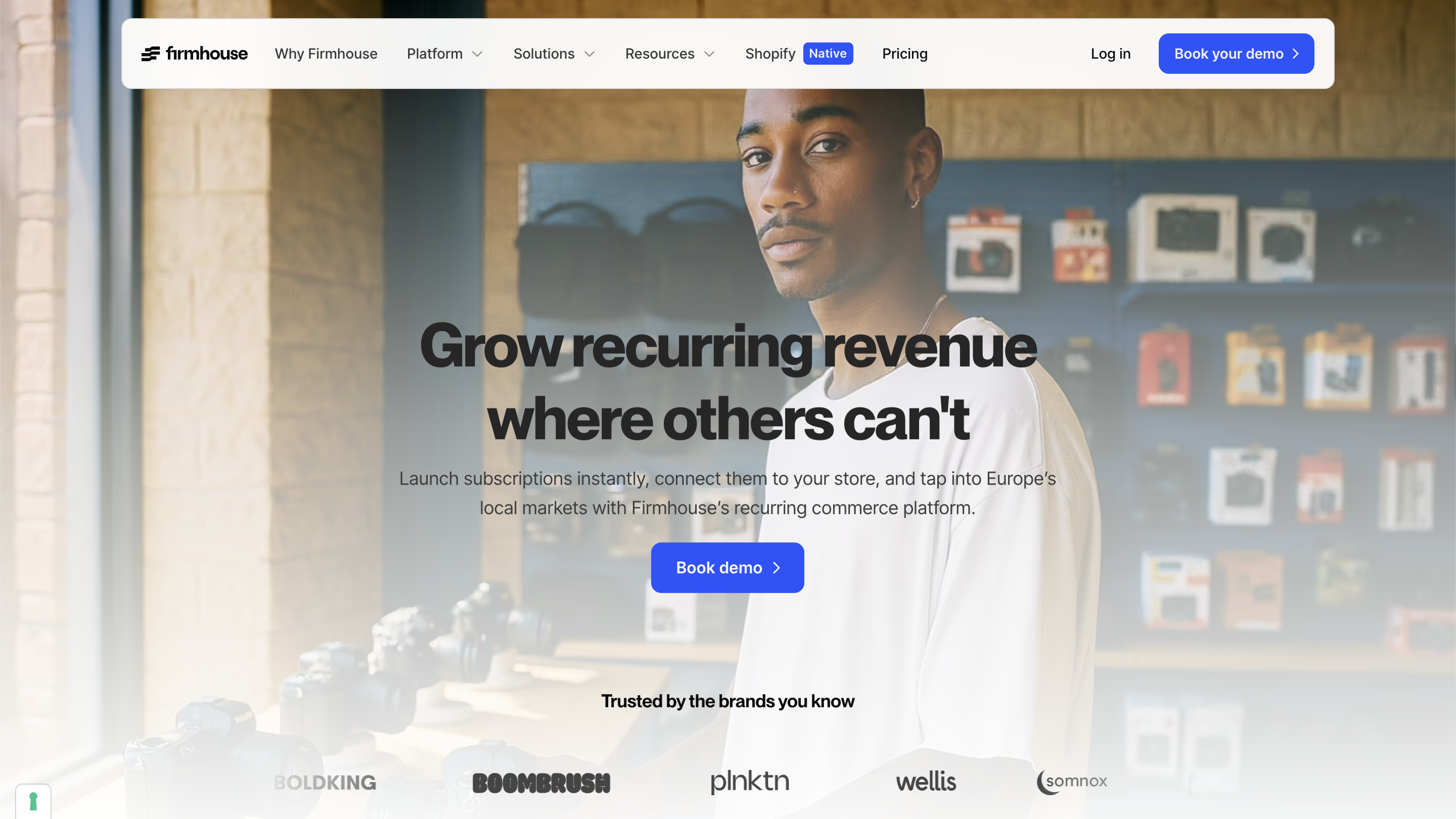
What it is
Firmhouse is a recurring commerce. They describe their offering as an all-in-one solution that helps businesses launch subscriptions, rentals, and consumption models.
Typical customers & industries
They tend to favor merchants using Shopify (or Shopify-native solutions), especially in the European market. heir site claims they support product subscriptions, rentals & leases, and hybrid models.
Core functionality
1. Subscription Checkout
Firmhouse lets you embed subscription and rental options directly into your store’s checkout. Customers can subscribe to products, manage renewals, or combine one-time and recurring purchases in a single transaction.
2. My Account (Customer Portal)
Through the “My Account” area, subscribers can manage their plans independently — pause, upgrade, or cancel — reducing manual support and improving customer retention.
3. Billing Automation
Firmhouse automates recurring billing and invoicing, ensuring customers are charged accurately and on time. It integrates with payment providers like Mollie and Stripe, simplifying payment collection and reconciliation.
4. CRM
The built-in CRM keeps all subscriber details, payment history, and subscription data in one place, making it easy to track customer relationships and monitor active accounts.
5. Communications
Automate essential customer notifications — from subscription confirmations to renewal reminders and failed payment alerts — to keep your customers informed throughout their lifecycle.
6. Protect
Firmhouse includes protection options for physical product subscriptions, helping businesses manage risks related to damage or loss during a rental or subscription period.
7. Churn Prevention
Prevent unnecessary cancellations with tools designed to retain customers. Offer flexible options like pausing or extending subscriptions, and use insights from customer behaviour to identify churn risks early.
#3 Fairown
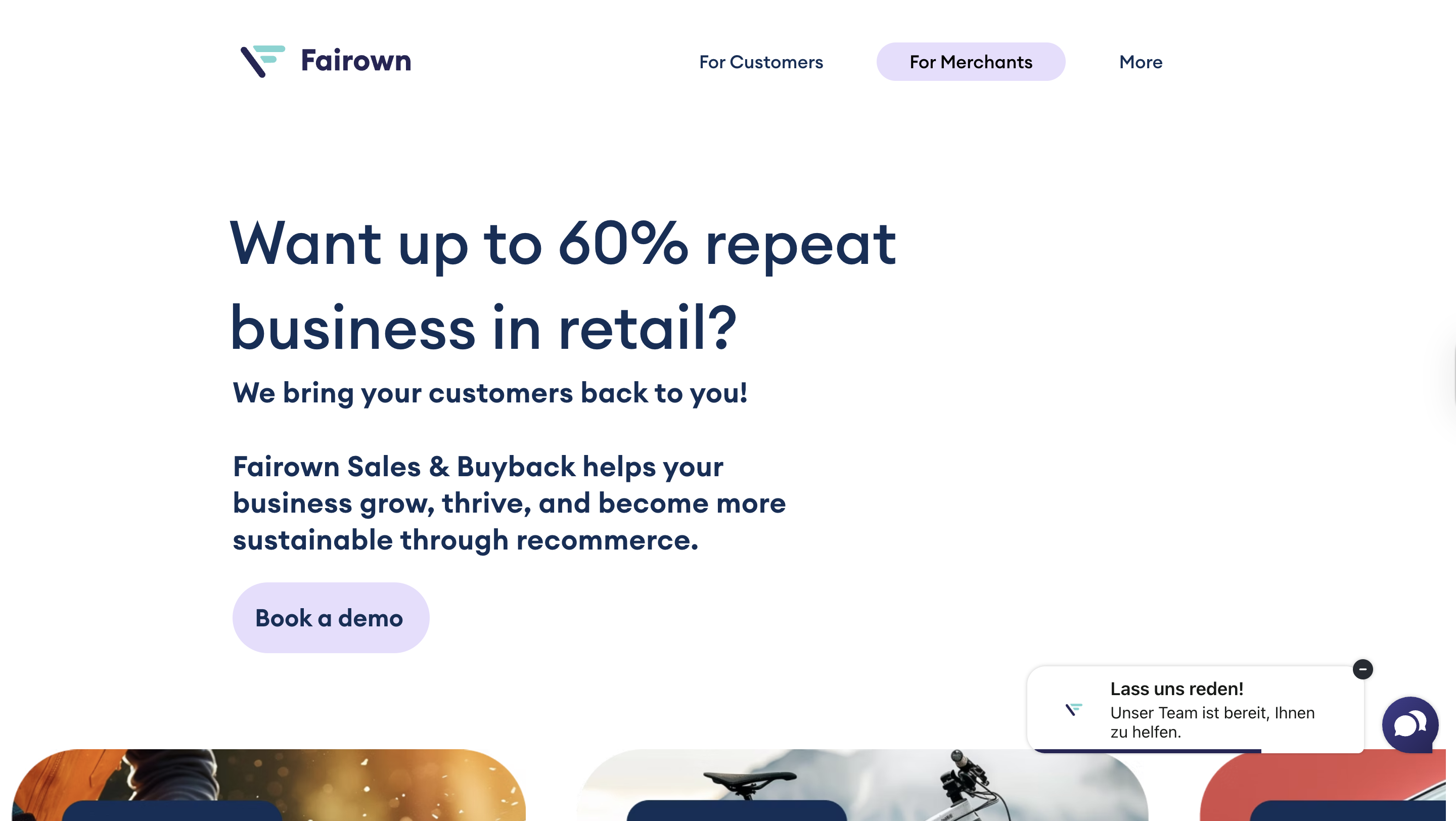
What it is
Fairown is a subscription and product lifecycle platform designed primarily for consumer durable goods in the Nordic and Baltic regions. The company positions itself around helping brands and retailers offer sustainable, circular ownership models — where products are leased, renewed, or bought back instead of being sold outright.
Unlike broad subscription management systems, Fairown operates closer to the financial and leasing layer, partnering with banks and financing institutions to handle recurring payments and buyback programs.
Typical Customers & Industries
Fairown mainly works with electronics, appliance, and home improvement brands looking to offer customers product access without full ownership. It’s particularly attractive to businesses in the Nordics that want to add a green or circular financing component to their product strategy, rather than run a full operational subscription model internally.
Core Functionality
1. White-Label Storefront & API Integration
Fairown provides a white-label online store for subscription sign-up and checkout. For brands with existing eCommerce setups, it offers API integrations to embed the same flow into the existing customer journey. While this covers the front-end experience well, it’s more focused on onboarding than ongoing subscription operations.
2. Pricing & Plan Configuration
The built-in pricing tool lets you define subscription terms such as duration, frequency, and renewal cycle in advance. These rules are typically fixed at setup, which can make it less flexible if renewal terms need to change mid-subscription — a limitation for operators managing long-term or variable product usage.
3. Subscription Management
Fairown’s backend acts as a unified dashboard for monitoring active subscriptions, renewals, and buybacks across channels. However, it’s more of a sales and finance control center than a deep operational system for managing logistics, returns, or asset condition tracking.
4. Recurring Billing
Billing and payment processing are handled through Fairown’s financial partners. This ensures predictable cash flow but gives businesses less direct control or visibility compared to platforms purpose-built for recurring operations like circuly.
5. Analytics
The platform offers basic analytics for tracking active subscriptions and renewals, giving brands high-level visibility into performance but not the granular asset or operational insights that subscription-first tools provide.
#4 Nitrobox - Billing & monetisiation platform
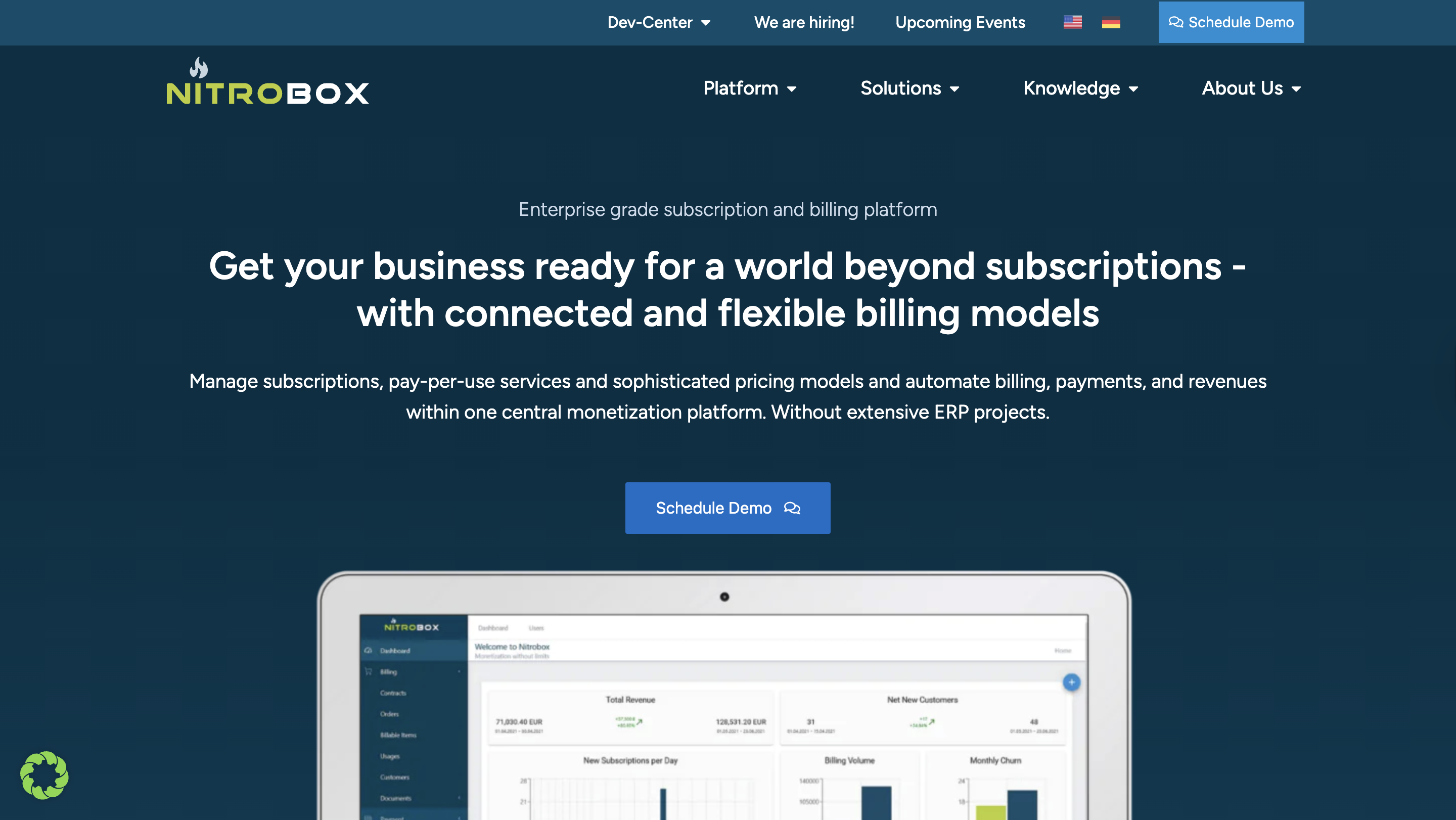
What It Is
Nitrobox is an enterprise-grade billing and monetisation platform designed to handle complex revenue models — from subscriptions and pay-per-use to hybrid and transactional models. The company focuses on automating the order-to-cash process, combining billing, payments, revenue recognition, and dunning in one system.
While Nitrobox often positions itself within the broader subscription economy, its main strength lies in financial automation and billing orchestration, rather than in operational subscription management for physical products.
Typical Customers & Industries
Nitrobox primarily serves enterprise and digital businesses — especially those in SaaS, mobility, telecom, and industrial sectors — that need sophisticated billing logic for hybrid or usage-based pricing models.
Most of Nitrobox’s customers use the platform for digital and service-based monetization, not for consumer durables or asset-heavy subscription businesses.
Core Functionality
1. Complex Billing & Monetisation
Nitrobox excels at managing complex pricing models — including one-time fees, recurring subscriptions, tiered pricing, usage-based billing, and multi-phase contract structures.
2. Order-to-Cash Automation
It covers the full financial workflow: contract creation, billing, invoice generation, payment processing, dunning, and revenue recognition — all within a unified system.
3. Recurring Billing & Invoicing
Businesses can automate recurring billing and create consolidated invoices for multiple contracts or accounts. The platform supports flexible billing cycles and international tax compliance.
4. APIs & Integrations
Nitrobox provides developer-focused APIs that allow it to integrate with CRMs, ERP systems, and custom eCommerce stacks, acting as the billing backbone of complex subscription architectures.
5. Analytics & Reporting:
The system includes dashboards for revenue, billing, and payment performance analytics, primarily geared toward finance teams rather than operational tracking.
#5 Topi
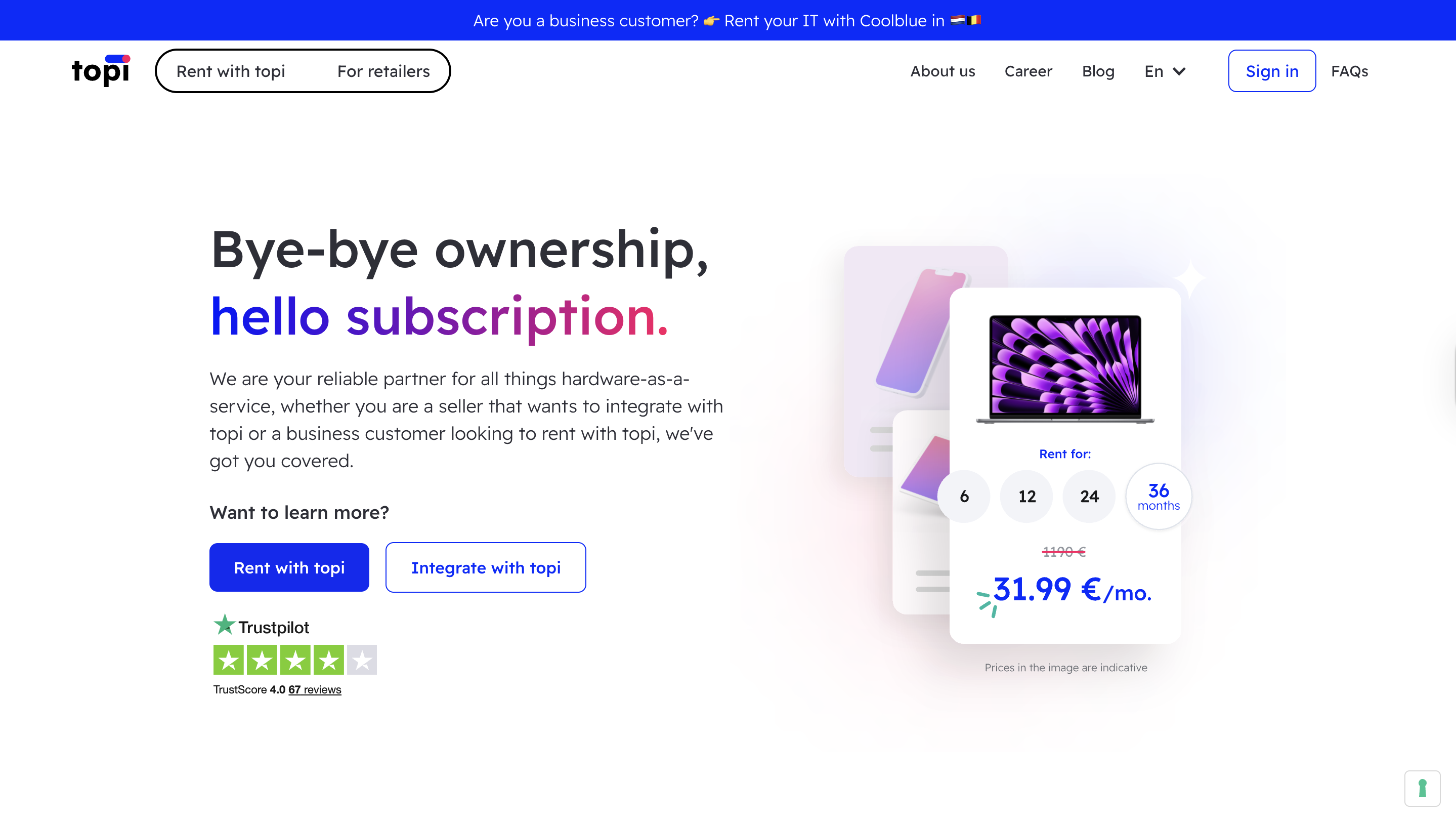
What It Is
Topi is a B2B hardware subscription and rental platform that enables retailers and manufacturers to offer IT devices and electronics as a service. The company provides a ready-to-integrate operational system that powers rental checkouts, helping merchants add a monthly payment option for business customers instead of one-time purchases.
Unlike traditional subscription software, Topi operates more like a financing and rental infrastructure — merchants receive their payment upfront, while Topi handles everything related to the rental, including credit risk, payments, and asset handling.
Typical Customers & Industries
Topi is built primarily for B2B retailers and manufacturers in the IT and electronics sector — companies that rent out laptops, tablets, smartphones, and accessories such as keyboards or protective covers.
Its customers are typically based in Germany, the Nordics, and the Benelux region, where Topi partners with selected retailers to bring hardware-as-a-service to business customers.
Core Functionality
1. Rental Checkout System
Topi provides a white-label checkout system that can be added to any online store. Business customers can select rental options at checkout, choose their rental duration (6–36 months), and complete their order in a few steps.
2. API Integration
For merchants with existing systems, Topi can be integrated directly into their customer journey through APIs — allowing the rental option to blend seamlessly into their eCommerce or in-store flow.
3. Instant Payouts & Financing
Retailers get paid immediately after a transaction, while Topi takes care of billing, payment collection, and risk management in the background. This makes it more of a financial enabler than a traditional subscription management system.
4. Credit & Risk Management
Topi includes an automated risk and decision engine that checks customer creditworthiness in real time, ensuring secure rentals and reducing default risks.
5. Product Lifecycle Options
At the end of the rental term, customers can upgrade, buy out, or return their devices. Returned items are refurbished or recycled through Topi’s partner network, supporting circular economy principles.
Operations to plan for when running a subscription business for physical products
Running a subscription business for physical products involves more than just setting up recurring billing. It’s an entirely different operational model that requires rethinking how you handle orders, payments, renewals, and more.
We've covered the topic in detail in this guide Subscription Management Software for Physical Products: What Makes It Different (and What to Look For).
Conclusion
The shift from ownership to access is reshaping every industry — and the tools behind it are evolving just as fast.As more brands explore product-as-a-service, the line between finance, logistics, and software will keep blurring — but the winners will be those who build systems around the product, not just the payment.
%20(23).png)


%20(25).png)
%20(24).png)
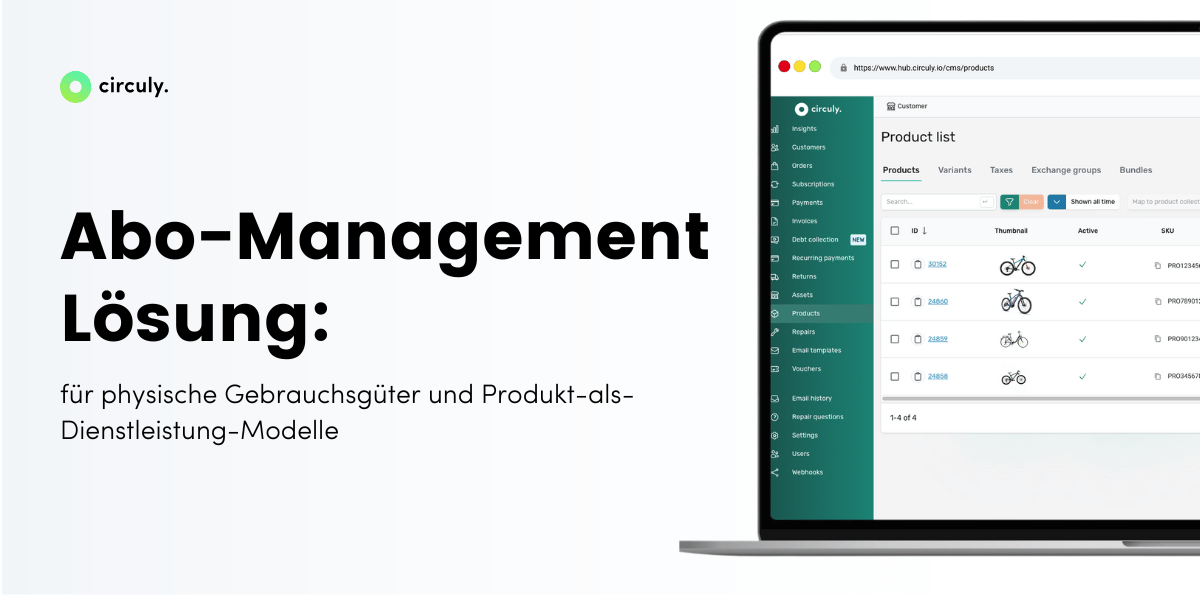




.png)





